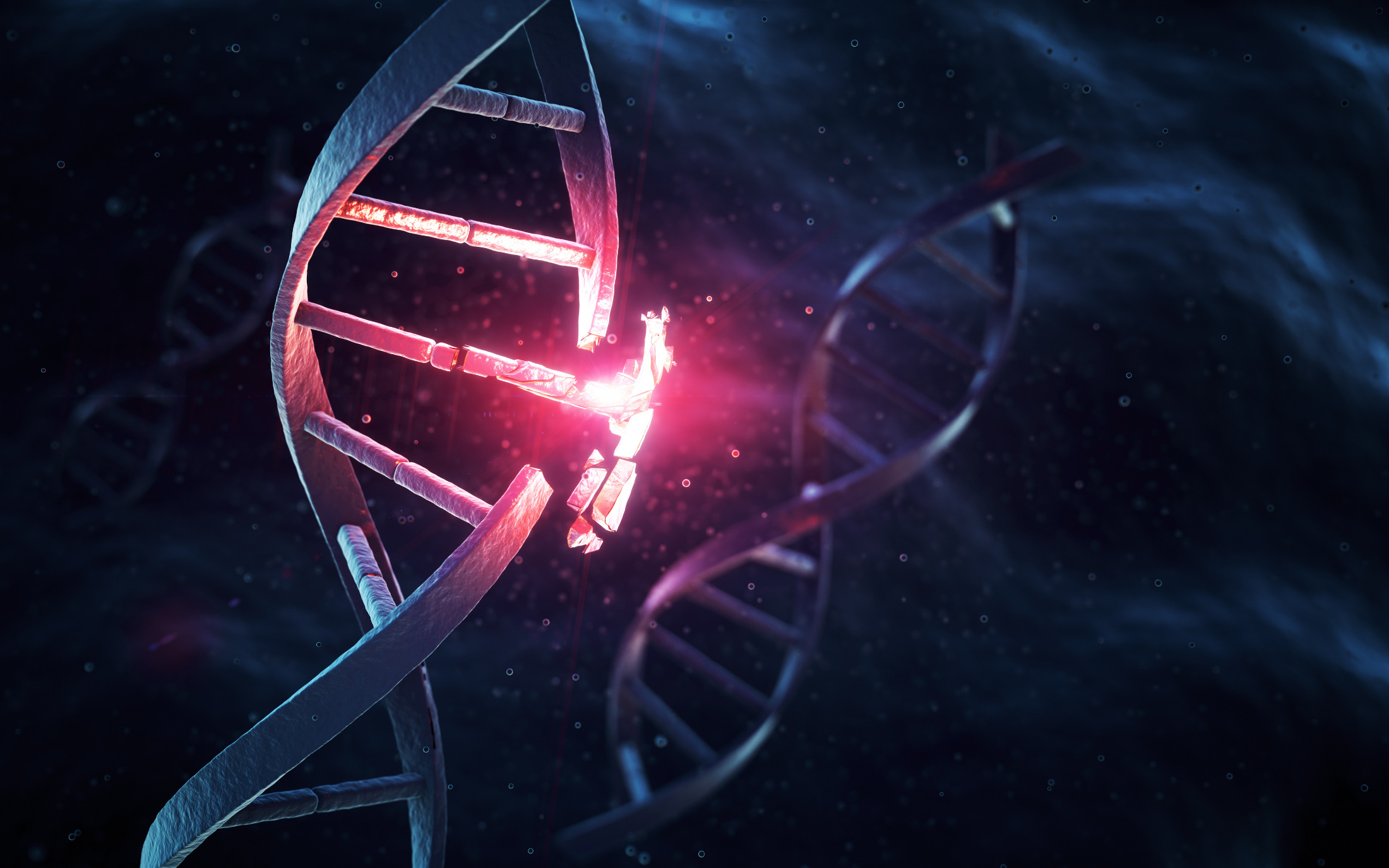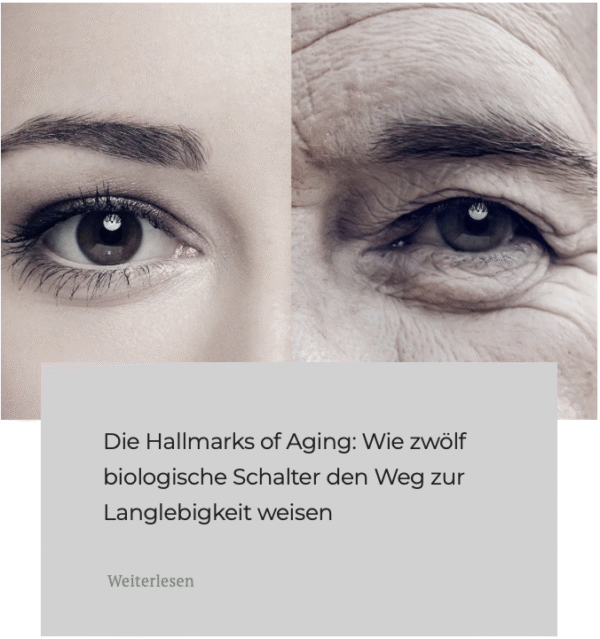Table of Contents:
- Why your DNA is damaged thousands of times every day
- Genomic instability – a key driver of the ageing process
- Your body fights – DNA repair systems in action
- How DNA damage leads to cancer and cell death
- Biohacking against genomic instability – What you can do
- The future of DNA repair – what research promises
- Protecting your genetic heritage

DNA is a masterpiece of nature. No question about it. However, it also proves to be a fragile structure in the course of ageing. Every day, each of your cells experiences up to 100,000 DNA damages. These molecular scratches, cracks and breaks – known as genetic instability – are a key driver of the ageing process. They are caused by “internal” factors such as cellular respiration or “external” influences such as genotoxic chemicals or ionizing radiation.
Research is becoming increasingly clear: genomic instability is a hallmark – we call it the“hallmarks of ageing”) and a fundamental driver of ageing. Why is your DNA so susceptible to damage? What mechanisms does your body have to repair it? And most importantly, how can you influence these processes to stay healthy for longer?
Why your DNA is damaged thousands of times every day
Imagine your DNA as a gigantic book with 3 billion letters – your personal blueprint. But this book is constantly under attack.
The attackers come from inside and outside. Internally, they are mainly reactive oxygen species – aggressive molecules that are produced as by-products of your metabolism. Externally, UV radiation, X-rays, environmental toxins and chemicals attack your genetic information. Every sunburn, every cigarette, every portion of highly processed food leaves traces in your genetic code.
Genomic instability – a key driver of the ageing process
In recent years, science has developed a revolutionary understanding of ageing. Groundbreaking studies have identified twelve fundamental “hallmarks of ageing” – molecular and cellular features that characterize the ageing process. Genomic instability is at the top of the list, as it affects virtually all other ageing processes. If your DNA is damaged and the repair mechanisms no longer work efficiently, a complex system is thrown out of balance: telomeres shorten more quickly, epigenetic patterns change, proteins become faulty, mitochondria no longer function optimally, cells become senescent. The entire body ages faster – all because the basic blueprint is damaged.
This might also interest you:
Your body fights – DNA repair systems in action
Fortunately, evolution has developed sophisticated repair systems. Your body has a complex network of mechanisms to recognize and repair DNA damage.
These molecular toolboxes work tirelessly to keep the genetic code intact. They cut out damaged sections of DNA, replace them with correct sequences and weld breaks together. At a young age, this system works amazingly efficiently.
With increasing age, however, these repair mechanisms lose their strength. The enzymes work more slowly, make more mistakes and some systems partially fail.
The result: DNA damage accumulates faster than it can be repaired – a vicious circle of genomic instability begins.
How DNA damage leads to cancer and cell death
If DNA damage is not repaired, your body has two main strategies: Apoptosis (programmed cell death) or senescence (cell aging). Both mechanisms are evolutionary protective measures to prevent the passing on of faulty genetic information. However, with age, these systems no longer function optimally.
Senescent cells accumulate, produce pro-inflammatory signaling substances and damage the surrounding tissue. At the same time, the risk of damaged cells escaping control and mutating into cancer cells increases.
The statistics are clear: the risk of cancer increases exponentially with every decade of life – a direct expression of accumulating genomic instability.
Biohacking against genomic instability – What you can do
The good news is that you can actively influence your genomic stability.
- An antioxidant-rich diet with lots of colorful vegetables and fruits provides your body with important protective substances against oxidative stress. Broccoli, blueberries and green tea, which have been shown to have a DNA-protecting effect, are particularly valuable.
. - Regular exercise reduces oxidative stress and improves the efficiency of DNA repair. Moderate exercise can increase the expression of repair enzymes.
. - At the same time Stress reductionn is crucial – chronic stress leads to increased production of free radicals and inhibits repair mechanisms.
. - There are promising approaches in the field of food supplements: Nicotinamide riboside (NR) and nicotinamide mononucleotide (NMN) increase the production of NAD+a molecule that is essential for DNA repair processes. Resveratrol and quercetin activate sirtuins – enzymes that help with genome stabilization.
The future of DNA repair – what research promises
Science is making rapid progress in understanding and influencing genomic instability. New technologies such as CRISPR-Cas9 could enable targeted repair of the genome in the future. Senolytics – substances that selectively remove senescent cells – are being intensively researched and could represent a revolution in ageing medicine.
Developments in strengthening the body’s own repair mechanisms are particularly exciting. Researchers are working on compounds that activate or stabilize DNA repair enzymes. Progeroid mouse models serve as valuable test systems for evaluating the effectiveness of such anti-ageing interventions.
Protecting your genetic heritage
Genomic instability is not an abstract scientific concept – it is the molecular clock of your ageing process. The good news is that with the right knowledge and targeted measures, you can actively influence it.
By making conscious lifestyle choices, strategically supplementing your diet and taking advantage of new scientific discoveries, you have the power to protect your DNA and lay the foundation for a longer, healthier life.
Your genetic heritage is precious – it deserves your active protection. Because in the end, longevity is no coincidence, but the result of conscious decisions at a molecular level.
Sources:
Nature – The central role of DNA damage in the ageing process
ScienceDirect – Hallmarks of aging: An expanding universe
Lifespan Research Institute – Why We Age: Genomic Instability
PMC – DNA Damage, DNA Repair, Aging, and Neurodegeneration
Frontiers – The use of progeroid DNA repair-deficient mice for assessing anti-aging compounds
🩺 Medically tested on 4.10.2025
This article has been professionally reviewed by Dr. Verena Immer. She is a doctor of integrative and anti-ageing medicine with a holistic approach that combines conventional medical knowledge with complementary methods. She has successfully applied the concept of individualized medicine in her own practice near Munich and currently offers personalized medicine – with a focus on longevity – in Switzerland.
Image source: istockphoto.com
The fragmentation and destruction of the genetic DNA molecule helix | credits @ spawns
Disclaimer
This blog is for general informational purposes only and does not constitute the practice of medicine, nursing or other professional health care services, including the giving of medical advice, and no doctor-patient relationship is established. Use of any information contained in this blog or materials linked to this blog is at the user’s own risk. The content of this blog is not intended as a substitute for professional medical advice, diagnosis or treatment. Users should not ignore or delay medical advice for any medical conditions they may have and should seek the help of their healthcare professional for such conditions.









